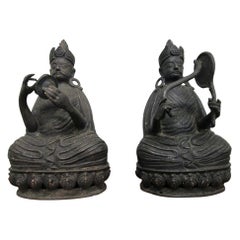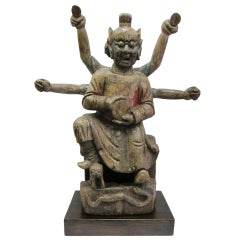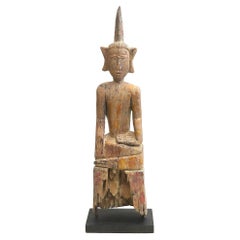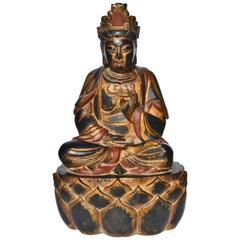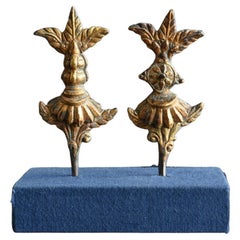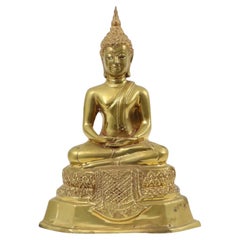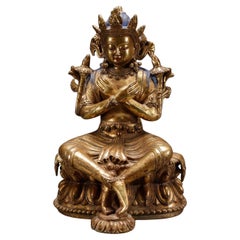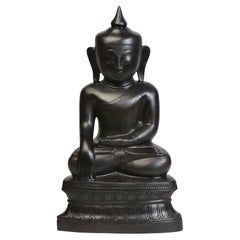Buddha Statues
Antique Late 18th Century Asian Sculptures
Bronze
Antique Early 1800s Burmese Figurative Sculptures
Alabaster
Antique 18th Century and Earlier Chinese Qing Sculptures
Wood
Antique 1890s Laotian Tribal Mounted Objects
Wood
20th Century Chinese Tang Sculptures and Carvings
Wood
Antique 17th Century Chinese Ming Figurative Sculptures
Copper
Vintage 1960s Thai Figurative Sculptures
Brass
Antique 1790s Tibetan Tibetan Figurative Sculptures
Bronze
21st Century and Contemporary Burmese Figurative Sculptures
Bronze
20th Century Chinese Tang Sculptures and Carvings
Stone
Antique Early 18th Century Unknown Figurative Sculptures
Wood
20th Century Chinese Chinese Export Figurative Sculptures
Clay
20th Century Tibetan Sculptures and Carvings
Bronze
Antique 19th Century Unknown Figurative Sculptures
Metal
Antique Early 1800s Thai Anglo-Indian Figurative Sculptures
Wood
Vintage 1950s Chinese Busts
Bronze
20th Century Tibetan Sculptures and Carvings
Bronze
Antique 18th Century Japanese Edo Figurative Sculptures
Cypress
20th Century Tibetan Tibetan Figurative Sculptures
Porcelain
Early 20th Century Chinese Figurative Sculptures
Bronze
20th Century Sculptures and Carvings
Bronze
Vintage 1940s Tibetan Primitive Figurative Sculptures
Copper
Antique Mid-18th Century Burmese Other Figurative Sculptures
Bronze
20th Century Chinese Chinese Export Figurative Sculptures
Clay
Vintage 1920s Figurative Sculptures
Rosewood
Antique 15th Century and Earlier Chinese Ming Figurative Sculptures
Terracotta
2010s Chinese Sculptures and Carvings
Multi-gemstone, Quartz
Antique 19th Century Chinese Figurative Sculptures
Porcelain
Early 20th Century Chinese Chinese Export Figurative Sculptures
Bronze
20th Century Chinese Chinese Export Figurative Sculptures
Clay
Antique 19th Century Chinese Chinese Export Figurative Sculptures
Bronze
Antique 1790s Asian Qing Figurative Sculptures
Wood, Giltwood
2010s Chinese Sculptures and Carvings
Stone
Mid-20th Century Japanese Showa Abstract Sculptures
Wood, Cedar
21st Century and Contemporary Pakistani Figurative Sculptures
Agate
20th Century Chinese Ming Sculptures and Carvings
Bronze
Mid-20th Century Chinese Tang Sculptures and Carvings
Stone
Late 20th Century Chinese Figurative Sculptures
Rose Quartz
Antique 19th Century Japanese Edo Figurative Sculptures
Cypress
20th Century Statues
Wood
20th Century Tibetan Sculptures and Carvings
Bronze
Early 20th Century Japanese Meiji Sculptures and Carvings
Wood, Giltwood, Lacquer, Paint
Antique 1890s Thai Other Sculptures and Carvings
Wood
Antique 18th Century Thai Sculptures and Carvings
Bronze
Antique 18th Century Thai Sculptures and Carvings
Bronze
Antique 18th Century Thai Sculptures and Carvings
Bronze
Mid-20th Century Thai Folk Art Sculptures and Carvings
Bronze
Antique 16th Century Thai Sculptures and Carvings
Bronze
Antique 19th Century Burmese Archaistic Sculptures
Stone
Mid-20th Century Thai Folk Art Sculptures and Carvings
Bronze
21st Century and Contemporary Thai Figurative Sculptures
Bronze
20th Century Chinese Tang Sculptures and Carvings
Stone
20th Century Tibetan Sculptures and Carvings
Bronze
20th Century Tibetan Sculptures and Carvings
Bronze
Antique 15th Century and Earlier Japanese Other Figurative Sculptures
Cypress
20th Century Chinoiserie Figurative Sculptures
Wood
20th Century Chinoiserie Figurative Sculptures
Wood
Antique 18th Century Laotian Archaistic Busts
Gold Leaf
- 1
Buddha Statues For Sale on 1stDibs
How Much are Buddha Statues?
Finding the Right Sculptures for You
Styling your home with vintage, new and antique sculptures means adding a touch that can meaningfully transform the space. By introducing a sculptural work as a decorative finish to any interior, you’re making a statement, whether you tend toward the dramatic or prefer to keep things casual with modest, understated art.
A single, one-of-a-kind three-dimensional figurative sculpture mounted on your dining room wall is a guaranteed conversation piece, while a trio of abstract works arranged on your living room bookshelves can add spontaneity to the collection of first-edition novels or artist monographs you’re displaying as well as draw attention to them. Figurative sculptures are representational works that portray a specific person, animal or object. And while decorating with busts, which are sculpted or cast figurative works, hasn’t exactly topped the list of design trends every year, busts are back. According to designer Timothy Corrigan, “They give humanity in a way that a more abstract sculpture can’t give.” Abstract sculptures, on the other hand, are not meant to show something specific. Instead, they invoke a mood or scene without directly stating what they are portraying.
Busts made of stone or metal may not seem like a good fit for your existing decor. Fortunately, there are many ways for a seemingly incongruous piece to fit in with the rest of your room’s theme. You can embrace a dramatic piece by making it the focal point of the room, or you can choose to incorporate several elements made out of the same material to create harmony in your space. If an antique or more dramatic piece doesn’t feel like you, why not opt for works comprising plastic, fiberglass or other more modern materials?
When incorporating sculpture into the design of your home — be it the playful work of auction hero and multimedia visionary KAWS, contemporary fiber art from Connecticut dealer browngrotta arts or still-life sculpture on a budget — consider proper lighting, which can bring out the distinctive aspects of your piece that deserve attention. And make sure you know how the size and form of the sculpture will affect your space in whole. If you choose a sculpture with dramatic design elements, such as sharp angles or bright colors, for example, try to better integrate this new addition by echoing those elements in the rest of your room’s design.
Get started on decorating with sculpture now — find figurative sculptures, animal sculptures and more on 1stDibs today.
 Lotus GallerySeptember 23, 2020
Lotus GallerySeptember 23, 2020Buddha statues are not inherently lucky or unlucky, though images of the Fat Buddha (Budai or Hotei), have come to be associated with wealth, knowledge, and luck, with people often rubbing the belly or head.
 PAGODA REDOctober 21, 2020
PAGODA REDOctober 21, 2020Most ritual figures depict the Buddha in one of three postures: seated, standing, or reclining. Differences in expression, hand gesture (mudras), and accompanying objects can reveal the figure’s place of origin as well as the particular Buddhist teaching depicted. Such Buddha figures are rendered in a variety of media depending on regional art traditions and intended use, ranging from carved stone to cast bronze to lacquered bamboo.
- 1stDibs ExpertApril 5, 2022The purpose of a Buddha statue relates to worship in the Buddhist faith. It provides a point of focus and reflection for Buddhists when they engage in the meditation required to achieve enlightenment. Find a selection of Buddha statues on 1stDibs.
- How do I choose a Buddha statue?1 Answer
 Lotus GallerySeptember 23, 2020
Lotus GallerySeptember 23, 2020A Buddha statue is very personal. You should choose one that speaks to you. If you are a practitioner, you can ask your teacher for assistance as well.
- Are Buddha statues Chinese?1 Answer1stDibs ExpertApril 5, 2022China is just one of the many countries that has a tradition of Buddhist sculpture. You can find Buddha statues from many other regions like India and Japan. On 1stDibs, you’ll find a collection of antique and modern Buddha statues from some of the world’s top sellers.
- What do Buddha statues mean?1 Answer1stDibs ExpertOctober 21, 2020
The most commonly represented Buddha in Chinese Buddhist sculpture is Siddhartha Gautama, also known as Shakyamuni, the Enlightened One, or the Gautama Buddha. He is typically depicted seated upon a lotus throne with his hands in the Bhumisparsha mudra, the Gesture of Witness. This gesture symbolizes the moment that the Buddha claimed the earth as witness to his enlightenment and celebrates his unwavering meditative focus.
- 1stDibs ExpertApril 5, 2022Identifying an antique Buddha statue is a specialized skill, which is best learned by studying the history of the preferred materials and techniques that each region used in producing Buddha statues. The simplest way to verify the age of a Buddha statue is to have an expert evaluate it. On 1stDibs, find a range of professionally authenticated Buddha statues.
Read More
Kazuyo Sejima’s Flowering Tree Blooms Year-Round
The brilliantly simple design turns a modest bouquet into a major statement.
He Wrote ‘Oedipus Rex,’ but Do You Know What He Looked Like?
The Greek tragedian is said to have been handsome in his day.
Cigar Culture Was Once the Peak of Masculinity. Now, It’s a Compelling Curiosity
Even for those who don’t indulge, elegant smoking accessories and audacious art portraying cigar enthusiasts hold a nostalgic allure.
African Travel Plans on Hold? This Ardmore Leopard Vase Brings the Beauty of the Savanna to You
It’s an excellent example of the sought-after ceramics coming out of South Africa’s KwaZulu-Natal province.
With a High-Tech Flagship and Cool Collabs, Lladró Is Breaking the Mold for Porcelain Production
Thanks to its new leadership, the Spanish maker of figurines, busts and lighting is on a mission to update the art of porcelain for the 21st century.
Zoë Powell’s Magnolia 05 Vessel Is Handmade from Clay She Unearthed Herself
The free-form stoneware piece is inspired by the magnolia tree and its associations with home.
8 Ways to Breathe New Life into a Space with Plants
The pair behind the Instagram account @houseplantclub share their tips for making any room of the house gloriously green.
Paris Gallerist Sandy Toupenet Gets Fired Up over 20th-Century Ceramics and Inventive New Makers
Her space on the city’s Left Bank mixes mid-century pieces by the likes of Jean Cocteau and Pablo Picasso with whimsical contemporary creations.
